Histology
Alok Anand MD Ashley Davidoff MD
The Common vein Copyright 2010
Introduction
The prostate is comprised of approximately 30% glandular and 70% fibromuscular stromal elements.
|
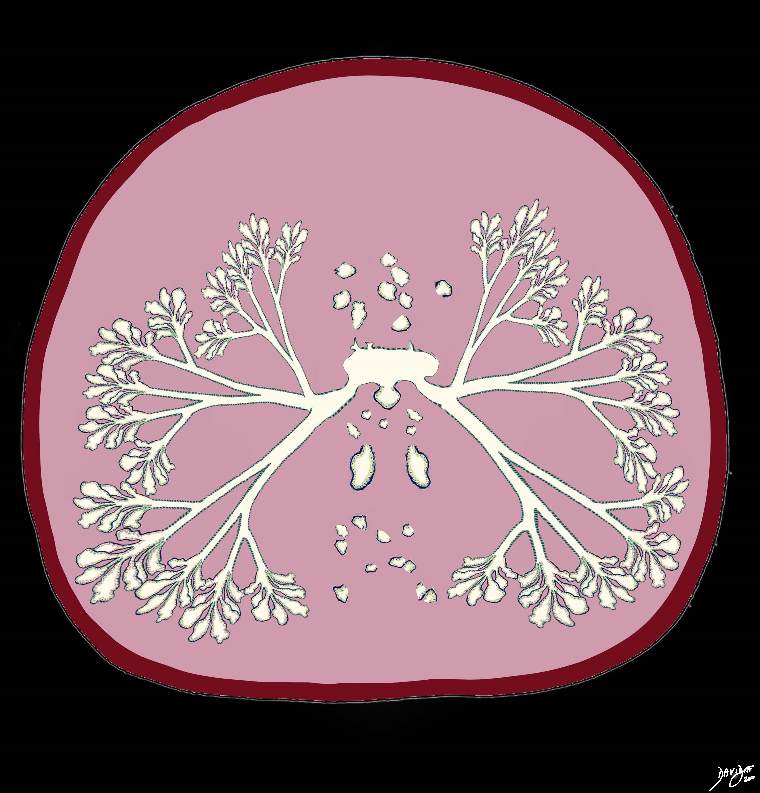
Glandular and Stromal Elements
|
|
The diagram reflects the basic histological makeup of the prostate in axial projection. It is composed of 30% glandular tissue (white) and 70% stromal tissue (pink). The glandular tissue is made up of branching tubuloalveolar glands and the stroma consists of smooth muscle, collagen, elastic tissue and fibrous tissue.
Image Courtesy Ashley Davidoff Copyright 2011 42707b03b45b050prb02.8s
|
There are two basic types of cells in the prostate; glandular or epithelial cells, and the stromal cells. Epithelial cells make up the glandular portion of the prostate and stromal cells make up the surrounding muscle and connective tissues. The interaction between the epithelial cells and stromal cells is relevant in the evolution of prostatic disease.
The epithelial cells take two forms;
The columnar cells are the secretory cells, and form 90% of the epithelial population. They are rich in acid phosphatase and prostate-specific antigen. The other epithelial cell type is the basal cell which is a small, undifferentiated, keratin-rich pluripotential cell. Basal cells form less than 10% of the epithelial cell population. These cells are responsible for regeneration of the epithelium. When they are present they form a second cell layer creating a pseudostratified appearance to the epithelium.
The fibromuscular stroma consists of smooth muscle separated by strands of connective tissue rich in collagenous and elastic fibers. The muscle is scattered in the gland, and also forms a dense ring around the urethra. Muscle is also found beneath the capsule of the prostrate.
The glandular elements are organized with tree like morphology and have a tubuloalveolar shape. A tubuloalveolar gland is named because it is a combination of a tube and a sphere meaning in essence that it is tear drop shaped
|
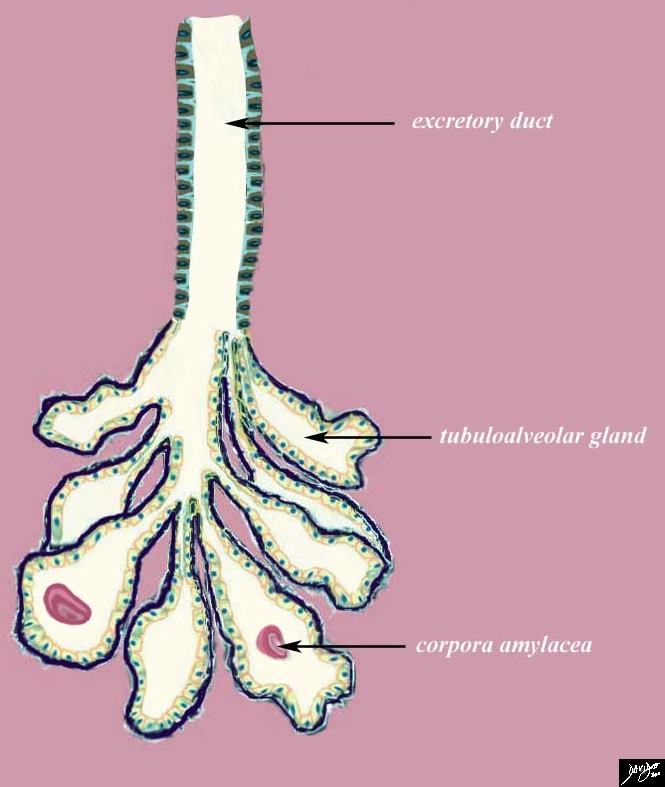
Tubuloalveolar Gland
Tear Drop Shape
|
|
The diagram reflects the histological makeup of the prostate characterised by tubuloalveolar glands reflecting their shape combining a tubular shape with a rounded shape to result in a tear drop shape. The epithelium of the glands or acini has irregular contours, and the gland is lined by a single layer of cuboidal or columnar cells. Characteristic also is the accumulation of concretions in the lumen called corpora amylacea which become calcified as the patient ages. These are shown as pink homogeneous concretions organized in layers (lamellated) in the lumen of the gland.
Image Courtesy Ashley Davidoff Copyright 2010 42707b03b45b043prL01.8s
|
The epithelium or lining of the glands is cuboidal or columnar which describes the shape of the individual cells as being either like a cube or like a column. It is usually a single layer of cells thick but may look pseudostratified and two layered when basal cells are present. The mucosa forms papillary projections into the lumen giving the alveoli an irregular shape.
A characteristic feature of the glands, especially in older patient are hyaline accumulations of thickened secretions that form in layers which are found in the lumen of the acinus or gland. These lamellated concretions are called corpora amylacea. The word corpus is derived from the Latin word corpus which means a body and amylacea is from the Latin word amylum which means starch or gruel. The clinical significance of the corpora amylacea is not known. They may also be found less commonly in the pulmonary alveoli.
The glandular elements comprise of about 30 – 50 tubuloalveolar glands, which empty into 15 – 25 independent excretory ducts. These ducts open into the urethra just lateral to the verumontanum where the ejaculatory ducts enter.
|
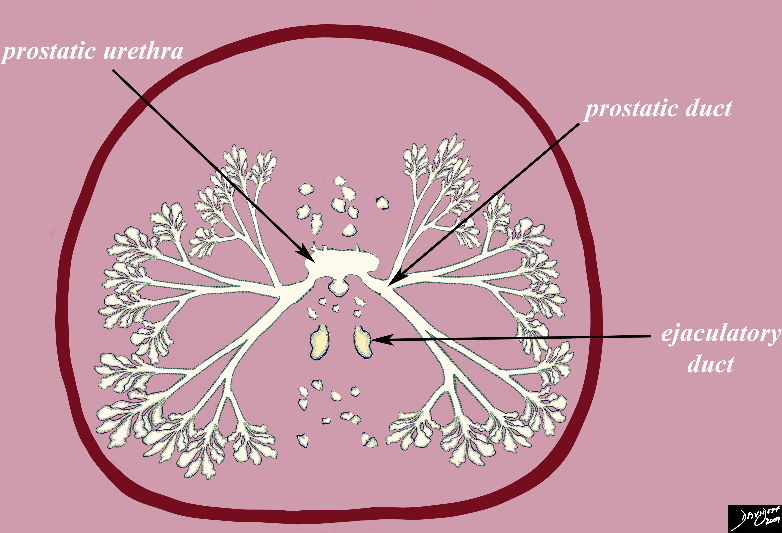
Major Ducts of the Prostate
Diagram of a Whole Prostate Mount in Axial Projection
|
|
The diagram reflects the histological makeup of the prostate with compound tubuloalveolar acini feeding into a system of ductules and finally forming 30-50 excretory ducts that enter into the prostatic urethra. In this diagram the two ejaculatory ducts are shown posterior to the prostatic urethra, and represent the confluence of the ducts of the seminal vesicles and the vasa deferentia. At a slightly more inferior level of the axial cut, they will enter the prostatic urethra at the verumontanum
Image Courtesy Ashley Davidoff Copyright 2010 42707b03b45b052prLb.8s
|
The largest component of stroma cells is the smooth muscle contribution. The smooth muscle cells are rich in actin and myosin. The smooth muscle is required for release of seminal secretions during ejaculation. The second major component of the stroma is fibroblastic tissue. The fibroblasts are rich in vimentin and fibronectin, and provide structural support to the gland.
|
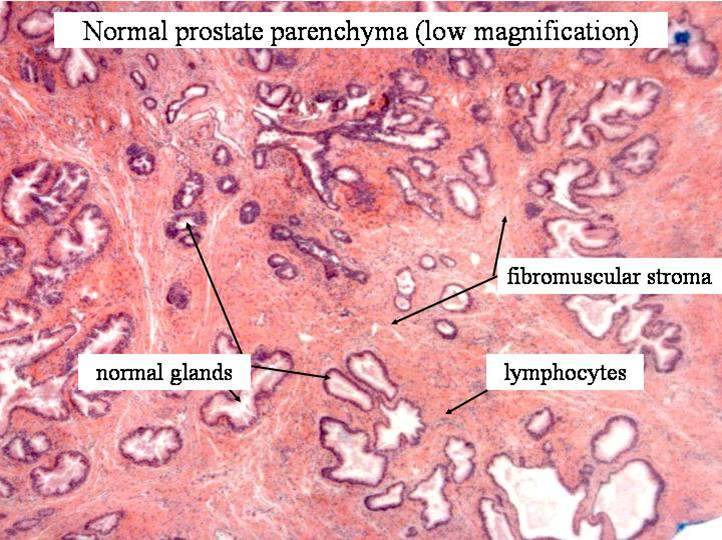
Histology of the Prostate
|
|
The H&E histologic specimen is taken at low power and shows the components of the prostatic gland including the glandular tissue, and fibromuscular stroma. In general the glandular tissue comprises 30% of the tissue and the fibromuscular component comprises 70%.
Courtesy Alex Perepletchikov, MD,PhD 98082b
|
|
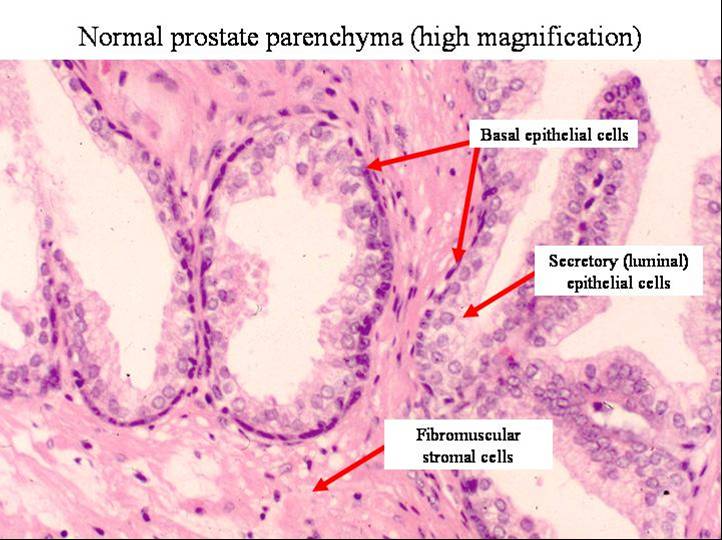
Histology Higher Magnification Showing Epithelial Cells
|
|
The H&E histologic specimen is taken at higher magnification and shows the cellular components of the epithelium. The basal cells are seen with darker nuclii and the secretory columnar cells are seen facing the lumen. The stroma is noted in between the glands consisting of smooth muscle and collagen.
Courtesy Alex Perepletchikov, MD,PhD 98083
|
Carcinoma of the prostate develops from the epithelial cells, but the interaction with the stromal cells is relevant to the prognosis and characteristics of prostate cancer.
BPH develops from the complex interactions between epithelial and stromal cells.
Testosterone interacts with both cell types.
DOMElement Object
(
[schemaTypeInfo] =>
[tagName] => td
[firstElementChild] => (object value omitted)
[lastElementChild] => (object value omitted)
[childElementCount] => 2
[previousElementSibling] =>
[nextElementSibling] =>
[nodeName] => td
[nodeValue] =>
Histology Higher Magnification Showing Epithelial Cells
[nodeType] => 1
[parentNode] => (object value omitted)
[childNodes] => (object value omitted)
[firstChild] => (object value omitted)
[lastChild] => (object value omitted)
[previousSibling] => (object value omitted)
[nextSibling] => (object value omitted)
[attributes] => (object value omitted)
[ownerDocument] => (object value omitted)
[namespaceURI] =>
[prefix] =>
[localName] => td
[baseURI] =>
[textContent] =>
Histology Higher Magnification Showing Epithelial Cells
)
DOMElement Object
(
[schemaTypeInfo] =>
[tagName] => td
[firstElementChild] => (object value omitted)
[lastElementChild] => (object value omitted)
[childElementCount] => 2
[previousElementSibling] =>
[nextElementSibling] =>
[nodeName] => td
[nodeValue] =>
Histology of the Prostate
[nodeType] => 1
[parentNode] => (object value omitted)
[childNodes] => (object value omitted)
[firstChild] => (object value omitted)
[lastChild] => (object value omitted)
[previousSibling] => (object value omitted)
[nextSibling] => (object value omitted)
[attributes] => (object value omitted)
[ownerDocument] => (object value omitted)
[namespaceURI] =>
[prefix] =>
[localName] => td
[baseURI] =>
[textContent] =>
Histology of the Prostate
)
DOMElement Object
(
[schemaTypeInfo] =>
[tagName] => table
[firstElementChild] => (object value omitted)
[lastElementChild] => (object value omitted)
[childElementCount] => 1
[previousElementSibling] => (object value omitted)
[nextElementSibling] => (object value omitted)
[nodeName] => table
[nodeValue] =>
Major Ducts of the Prostate
Diagram of a Whole Prostate Mount in Axial Projection
The diagram reflects the histological makeup of the prostate with compound tubuloalveolar acini feeding into a system of ductules and finally forming 30-50 excretory ducts that enter into the prostatic urethra. In this diagram the two ejaculatory ducts are shown posterior to the prostatic urethra, and represent the confluence of the ducts of the seminal vesicles and the vasa deferentia. At a slightly more inferior level of the axial cut, they will enter the prostatic urethra at the verumontanum
Image Courtesy Ashley Davidoff Copyright 2010 42707b03b45b052prLb.8s
[nodeType] => 1
[parentNode] => (object value omitted)
[childNodes] => (object value omitted)
[firstChild] => (object value omitted)
[lastChild] => (object value omitted)
[previousSibling] => (object value omitted)
[nextSibling] => (object value omitted)
[attributes] => (object value omitted)
[ownerDocument] => (object value omitted)
[namespaceURI] =>
[prefix] =>
[localName] => table
[baseURI] =>
[textContent] =>
Major Ducts of the Prostate
Diagram of a Whole Prostate Mount in Axial Projection
The diagram reflects the histological makeup of the prostate with compound tubuloalveolar acini feeding into a system of ductules and finally forming 30-50 excretory ducts that enter into the prostatic urethra. In this diagram the two ejaculatory ducts are shown posterior to the prostatic urethra, and represent the confluence of the ducts of the seminal vesicles and the vasa deferentia. At a slightly more inferior level of the axial cut, they will enter the prostatic urethra at the verumontanum
Image Courtesy Ashley Davidoff Copyright 2010 42707b03b45b052prLb.8s
)
DOMElement Object
(
[schemaTypeInfo] =>
[tagName] => td
[firstElementChild] => (object value omitted)
[lastElementChild] => (object value omitted)
[childElementCount] => 2
[previousElementSibling] =>
[nextElementSibling] =>
[nodeName] => td
[nodeValue] =>
The diagram reflects the histological makeup of the prostate with compound tubuloalveolar acini feeding into a system of ductules and finally forming 30-50 excretory ducts that enter into the prostatic urethra. In this diagram the two ejaculatory ducts are shown posterior to the prostatic urethra, and represent the confluence of the ducts of the seminal vesicles and the vasa deferentia. At a slightly more inferior level of the axial cut, they will enter the prostatic urethra at the verumontanum
Image Courtesy Ashley Davidoff Copyright 2010 42707b03b45b052prLb.8s
[nodeType] => 1
[parentNode] => (object value omitted)
[childNodes] => (object value omitted)
[firstChild] => (object value omitted)
[lastChild] => (object value omitted)
[previousSibling] => (object value omitted)
[nextSibling] => (object value omitted)
[attributes] => (object value omitted)
[ownerDocument] => (object value omitted)
[namespaceURI] =>
[prefix] =>
[localName] => td
[baseURI] =>
[textContent] =>
The diagram reflects the histological makeup of the prostate with compound tubuloalveolar acini feeding into a system of ductules and finally forming 30-50 excretory ducts that enter into the prostatic urethra. In this diagram the two ejaculatory ducts are shown posterior to the prostatic urethra, and represent the confluence of the ducts of the seminal vesicles and the vasa deferentia. At a slightly more inferior level of the axial cut, they will enter the prostatic urethra at the verumontanum
Image Courtesy Ashley Davidoff Copyright 2010 42707b03b45b052prLb.8s
)
DOMElement Object
(
[schemaTypeInfo] =>
[tagName] => td
[firstElementChild] => (object value omitted)
[lastElementChild] => (object value omitted)
[childElementCount] => 3
[previousElementSibling] =>
[nextElementSibling] =>
[nodeName] => td
[nodeValue] =>
Major Ducts of the Prostate
Diagram of a Whole Prostate Mount in Axial Projection
[nodeType] => 1
[parentNode] => (object value omitted)
[childNodes] => (object value omitted)
[firstChild] => (object value omitted)
[lastChild] => (object value omitted)
[previousSibling] => (object value omitted)
[nextSibling] => (object value omitted)
[attributes] => (object value omitted)
[ownerDocument] => (object value omitted)
[namespaceURI] =>
[prefix] =>
[localName] => td
[baseURI] =>
[textContent] =>
Major Ducts of the Prostate
Diagram of a Whole Prostate Mount in Axial Projection
)
DOMElement Object
(
[schemaTypeInfo] =>
[tagName] => table
[firstElementChild] => (object value omitted)
[lastElementChild] => (object value omitted)
[childElementCount] => 1
[previousElementSibling] => (object value omitted)
[nextElementSibling] => (object value omitted)
[nodeName] => table
[nodeValue] =>
Tubuloalveolar Gland
Tear Drop Shape
The diagram reflects the histological makeup of the prostate characterised by tubuloalveolar glands reflecting their shape combining a tubular shape with a rounded shape to result in a tear drop shape. The epithelium of the glands or acini has irregular contours, and the gland is lined by a single layer of cuboidal or columnar cells. Characteristic also is the accumulation of concretions in the lumen called corpora amylacea which become calcified as the patient ages. These are shown as pink homogeneous concretions organized in layers (lamellated) in the lumen of the gland.
Image Courtesy Ashley Davidoff Copyright 2010 42707b03b45b043prL01.8s
[nodeType] => 1
[parentNode] => (object value omitted)
[childNodes] => (object value omitted)
[firstChild] => (object value omitted)
[lastChild] => (object value omitted)
[previousSibling] => (object value omitted)
[nextSibling] => (object value omitted)
[attributes] => (object value omitted)
[ownerDocument] => (object value omitted)
[namespaceURI] =>
[prefix] =>
[localName] => table
[baseURI] =>
[textContent] =>
Tubuloalveolar Gland
Tear Drop Shape
The diagram reflects the histological makeup of the prostate characterised by tubuloalveolar glands reflecting their shape combining a tubular shape with a rounded shape to result in a tear drop shape. The epithelium of the glands or acini has irregular contours, and the gland is lined by a single layer of cuboidal or columnar cells. Characteristic also is the accumulation of concretions in the lumen called corpora amylacea which become calcified as the patient ages. These are shown as pink homogeneous concretions organized in layers (lamellated) in the lumen of the gland.
Image Courtesy Ashley Davidoff Copyright 2010 42707b03b45b043prL01.8s
)
DOMElement Object
(
[schemaTypeInfo] =>
[tagName] => td
[firstElementChild] => (object value omitted)
[lastElementChild] => (object value omitted)
[childElementCount] => 2
[previousElementSibling] =>
[nextElementSibling] =>
[nodeName] => td
[nodeValue] =>
The diagram reflects the histological makeup of the prostate characterised by tubuloalveolar glands reflecting their shape combining a tubular shape with a rounded shape to result in a tear drop shape. The epithelium of the glands or acini has irregular contours, and the gland is lined by a single layer of cuboidal or columnar cells. Characteristic also is the accumulation of concretions in the lumen called corpora amylacea which become calcified as the patient ages. These are shown as pink homogeneous concretions organized in layers (lamellated) in the lumen of the gland.
Image Courtesy Ashley Davidoff Copyright 2010 42707b03b45b043prL01.8s
[nodeType] => 1
[parentNode] => (object value omitted)
[childNodes] => (object value omitted)
[firstChild] => (object value omitted)
[lastChild] => (object value omitted)
[previousSibling] => (object value omitted)
[nextSibling] => (object value omitted)
[attributes] => (object value omitted)
[ownerDocument] => (object value omitted)
[namespaceURI] =>
[prefix] =>
[localName] => td
[baseURI] =>
[textContent] =>
The diagram reflects the histological makeup of the prostate characterised by tubuloalveolar glands reflecting their shape combining a tubular shape with a rounded shape to result in a tear drop shape. The epithelium of the glands or acini has irregular contours, and the gland is lined by a single layer of cuboidal or columnar cells. Characteristic also is the accumulation of concretions in the lumen called corpora amylacea which become calcified as the patient ages. These are shown as pink homogeneous concretions organized in layers (lamellated) in the lumen of the gland.
Image Courtesy Ashley Davidoff Copyright 2010 42707b03b45b043prL01.8s
)
DOMElement Object
(
[schemaTypeInfo] =>
[tagName] => td
[firstElementChild] => (object value omitted)
[lastElementChild] => (object value omitted)
[childElementCount] => 3
[previousElementSibling] =>
[nextElementSibling] =>
[nodeName] => td
[nodeValue] =>
Tubuloalveolar Gland
Tear Drop Shape
[nodeType] => 1
[parentNode] => (object value omitted)
[childNodes] => (object value omitted)
[firstChild] => (object value omitted)
[lastChild] => (object value omitted)
[previousSibling] => (object value omitted)
[nextSibling] => (object value omitted)
[attributes] => (object value omitted)
[ownerDocument] => (object value omitted)
[namespaceURI] =>
[prefix] =>
[localName] => td
[baseURI] =>
[textContent] =>
Tubuloalveolar Gland
Tear Drop Shape
)
DOMElement Object
(
[schemaTypeInfo] =>
[tagName] => table
[firstElementChild] => (object value omitted)
[lastElementChild] => (object value omitted)
[childElementCount] => 1
[previousElementSibling] => (object value omitted)
[nextElementSibling] => (object value omitted)
[nodeName] => table
[nodeValue] =>
Glandular and Stromal Elements
The diagram reflects the basic histological makeup of the prostate in axial projection. It is composed of 30% glandular tissue (white) and 70% stromal tissue (pink). The glandular tissue is made up of branching tubuloalveolar glands and the stroma consists of smooth muscle, collagen, elastic tissue and fibrous tissue.
Image Courtesy Ashley Davidoff Copyright 2011 42707b03b45b050prb02.8s
[nodeType] => 1
[parentNode] => (object value omitted)
[childNodes] => (object value omitted)
[firstChild] => (object value omitted)
[lastChild] => (object value omitted)
[previousSibling] => (object value omitted)
[nextSibling] => (object value omitted)
[attributes] => (object value omitted)
[ownerDocument] => (object value omitted)
[namespaceURI] =>
[prefix] =>
[localName] => table
[baseURI] =>
[textContent] =>
Glandular and Stromal Elements
The diagram reflects the basic histological makeup of the prostate in axial projection. It is composed of 30% glandular tissue (white) and 70% stromal tissue (pink). The glandular tissue is made up of branching tubuloalveolar glands and the stroma consists of smooth muscle, collagen, elastic tissue and fibrous tissue.
Image Courtesy Ashley Davidoff Copyright 2011 42707b03b45b050prb02.8s
)
DOMElement Object
(
[schemaTypeInfo] =>
[tagName] => td
[firstElementChild] => (object value omitted)
[lastElementChild] => (object value omitted)
[childElementCount] => 2
[previousElementSibling] =>
[nextElementSibling] =>
[nodeName] => td
[nodeValue] =>
The diagram reflects the basic histological makeup of the prostate in axial projection. It is composed of 30% glandular tissue (white) and 70% stromal tissue (pink). The glandular tissue is made up of branching tubuloalveolar glands and the stroma consists of smooth muscle, collagen, elastic tissue and fibrous tissue.
Image Courtesy Ashley Davidoff Copyright 2011 42707b03b45b050prb02.8s
[nodeType] => 1
[parentNode] => (object value omitted)
[childNodes] => (object value omitted)
[firstChild] => (object value omitted)
[lastChild] => (object value omitted)
[previousSibling] => (object value omitted)
[nextSibling] => (object value omitted)
[attributes] => (object value omitted)
[ownerDocument] => (object value omitted)
[namespaceURI] =>
[prefix] =>
[localName] => td
[baseURI] =>
[textContent] =>
The diagram reflects the basic histological makeup of the prostate in axial projection. It is composed of 30% glandular tissue (white) and 70% stromal tissue (pink). The glandular tissue is made up of branching tubuloalveolar glands and the stroma consists of smooth muscle, collagen, elastic tissue and fibrous tissue.
Image Courtesy Ashley Davidoff Copyright 2011 42707b03b45b050prb02.8s
)
DOMElement Object
(
[schemaTypeInfo] =>
[tagName] => td
[firstElementChild] => (object value omitted)
[lastElementChild] => (object value omitted)
[childElementCount] => 2
[previousElementSibling] =>
[nextElementSibling] =>
[nodeName] => td
[nodeValue] =>
Glandular and Stromal Elements
[nodeType] => 1
[parentNode] => (object value omitted)
[childNodes] => (object value omitted)
[firstChild] => (object value omitted)
[lastChild] => (object value omitted)
[previousSibling] => (object value omitted)
[nextSibling] => (object value omitted)
[attributes] => (object value omitted)
[ownerDocument] => (object value omitted)
[namespaceURI] =>
[prefix] =>
[localName] => td
[baseURI] =>
[textContent] =>
Glandular and Stromal Elements
)





